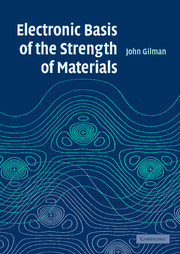Book contents
- Frontmatter
- Contents
- Preface
- Section I Introduction
- Section II Elements of solid mechanics
- Section III Elements of electron mechanics
- Section IV Elastic stiffness
- Section V Plastic strength
- 16 Macroscopic plastic deformation
- 17 Microscopic plastic deformation
- 18 Dislocation mobility
- Section VI Fracture resistance
- Index
- References
16 - Macroscopic plastic deformation
Published online by Cambridge University Press: 14 August 2009
- Frontmatter
- Contents
- Preface
- Section I Introduction
- Section II Elements of solid mechanics
- Section III Elements of electron mechanics
- Section IV Elastic stiffness
- Section V Plastic strength
- 16 Macroscopic plastic deformation
- 17 Microscopic plastic deformation
- 18 Dislocation mobility
- Section VI Fracture resistance
- Index
- References
Summary
Some solids are very hard and brittle, while others are soft and ductile. These differing behaviors are related to differences in resistance to plastic flow. Continuum mechanics cannot account for the differences. A quantum theory is required. In the case of plastic flow there are two levels of quantization that must be considered. The first is that, unlike elasticity, plastic flow is not a homogeneous process. It requires the inhomogeneous creation and propagation of dislocation lines. The displacements at these lines are quantized. The second is that dislocation lines themselves do not move homogeneously, except in simple metals. Kinks form on the lines. The displacements at these kinks localize and quantize the mobility process. Therefore, the wave mechanics of the bonding electrons determines the kink mobilities which in turn determine hardness and softness. Only by combining classical and quantum mechanics can a complete solid mechanics theory be developed.
Strong structures fail either because elastic deflections become too large in them, or because plastic flow occurs leading to large plastic deflections, or worse to fracture. Thus an understanding of the nature of plastic resistance is important for the design of strong structures. The subject is very complex because plastic flow is so very heterogeneous, at virtually every one of the 12 levels of aggregation from atoms to large engineering structures. At each level the heterogeneity manifests itself in different ways, all of which tend to be complicated. Therefore, no attempt will be made here to discuss the subject as a whole.
- Type
- Chapter
- Information
- Electronic Basis of the Strength of Materials , pp. 185 - 192Publisher: Cambridge University PressPrint publication year: 2003



